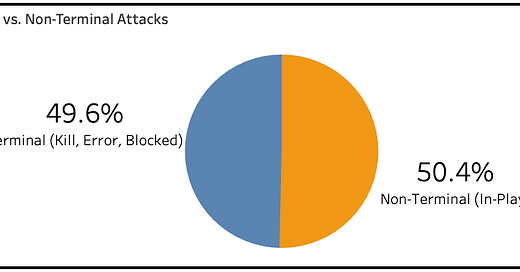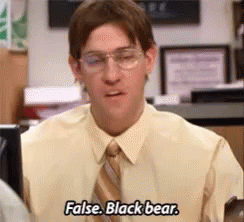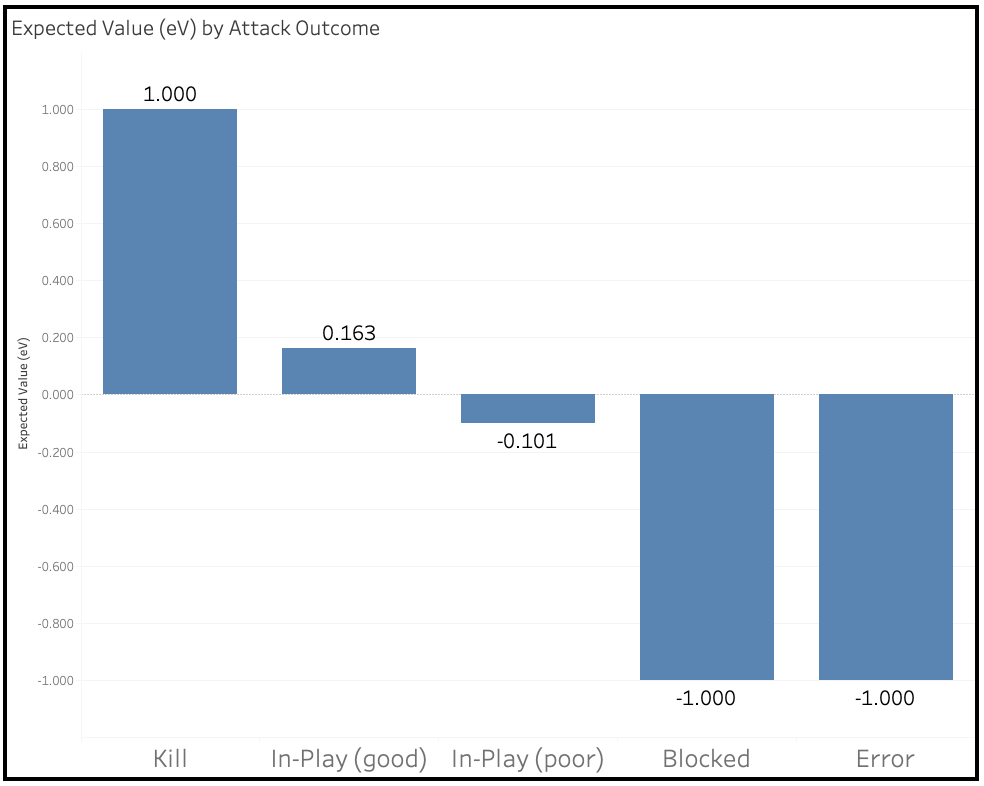I dedicate the first three weeks of each month to indoor volleyball and the fourth week to beach volleyball. Since there’s 5 weeks (or at least, 5 Mondays) in November, I’ll use this week for some random odds and ends that don’t quite fit into full articles. Today I’m sharing a guest post from one of the best analytical minds in volleyball: Chad Gordon.
I’ve been reading Chad’s blog for a while, and he had a great appearance on the CYBO podcast. Recommended reading and listening. His gif game is also far ahead of mine.
The biggest takeaway for me from this post I’m sharing is simply the first image. At most levels of volleyball, about half of attack attempts are not terminal. Are we considering that as coaches? This ties into the “better zeroes” concept that I touched on my recent CYBO appearance.
ALSO: On Wednesday, Dec 8 I’m doing an online workshop with the one and only Riley Salmon. We’re going to talk Serving and Passing and break down some video. We’ll also do some live Q&A and open it up to Smarter Volley subscribers. I want to keep the session small enough for everybody to participate and get the chance to ask questions and interact, so the first 10 subscribers to post a comment can join the session. (Update: 6 spots left.) (Update update: all full) No cost! The session is at noon PT, 3pm ET. I’ll put the video up later that week.
If he’s a good hitter, why doesn’t he hit good?
1. Welcome to attacking: the most important skill in our game. I’d also argue it’s the most interesting, least understood, and most dynamic of our game – making it the best place to pick some low-hanging fruit.
2. We need to understand the reality of attacking. As you can see above, only half of attacks result in a point.
3. Doing some quick math, that means that we essentially ignore 50% of the most important skill in volleyball. Yes most stats are looked at as a rate, meaning Kills / Attempts or (K – E – B) / Attempts. But by default, we are treating all non-terminal attacks the same, worth exactly 0 points. Are they really all equal? Are they really all worth exactly zero?
4. Alright, so you’re the coach – Bobby takes 10 swings: 4 kills, 1 error, and tips the other 5 to the libero. Billy also gets 10 swings: 4 kills, 1 error, crushes 3 other balls and forces an OOS attack from the opponent, and twice he chips the ball into the block and his team covers him and they attack again. Both guys are hitting 0.300, so they’re the same right? Well, there are basically two schools of thought.
5. I’m kidding, one school of thought. We naturally understand that forcing your opponent into an OOS attack rather than something in-system is better…but just how much better? 2x? 3x? 10x? And what about Billy, who chips the ball into the block – he basically creates another attack attempt for his team, that’s gotta be worth some love too right?
6. So the question becomes, how do I assign a value to something that doesn’t result in a point? The same way we do it for Serve Receive. By looking at your likelihood of winning the rally as a result of your action.
6.5 Given the specific outcomes, take (Won Rallies – Lost Rallies) / Attack Attempts >> this is Expected Value
7. Unfortunately, VolleyMetrics doesn’t give us a lot to work with. For attacking, there are 5 codes that translate to the x-axis variables above. 3 of which correspond to Terminal swings, leaving only 2 codes for in-play attacks and 5. These are Attack+ and Attack- (what I’ve labeled “In-Play (good) & In-Play (poor), respectively). They’re mostly useless, but even in their uselessness, they paint a picture.
8. Alright, you’re the coach again. Reframe the original question. Bobby, the tipper, gets 4 kills, 1 error, and 5 “poor” in-play attacks. Billy, the wunderkind, gets 4 kills, 1 error, and 5 “good” in-play attacks. Which bear is best? (bonus points for working wunderkind into the mix)
9. Do math.
Bobby: ((4 * 1.000) + (1 * -1.000) + (5 * -0.101)) / 10 = 0.250
Billy: ((4 * 1.000) + (1 * -1.000) + (5 * 0.163)) / 10 = 0.382
10. That’s a freaking 132 point gap.
11. I’d argue most coaches wouldn’t hesitate to bench Bobby in favor of Billy if this is how they viewed attack efficiency – even though their traditional “hitting efficiencies” were equivalent at 0.300.
12. We lose track of this gap, because on a single swing, +0.163 vs. -0.101 doesn’t look that different to the naked eye, neither attack ended the rally & since rallies are fast, we move on to the next sequence. But taken in the aggregate, these differences really start to add up – especially because until now, we’ve only been evaluating 50% of attacks correctly.
13. Back to the title: If he’s a good hitter, why doesn’t he hit good? “There is an epidemic failure within the game to understand what is really happening”
14. Now just think, what if instead of only using Attack+ and Attack-, we used more specific situations to evaluate attackers: finding the value of a perfect dig for the opponent vs. a poor dig for the opponent vs. dig that results in an overpass for us vs. a recycle off the block that we cover and are in-system on vs. ….. you get the idea. What if we look at all the possible outcomes when we attack & find the Expected Value for each of them & then gave appropriate credit when and where it’s due? That’d be cool.







This mindful approach to the game is what separates the giants from the pretenders.